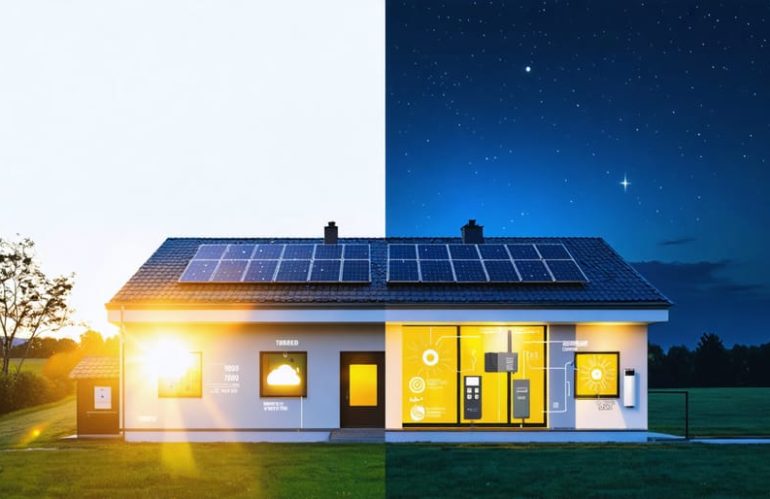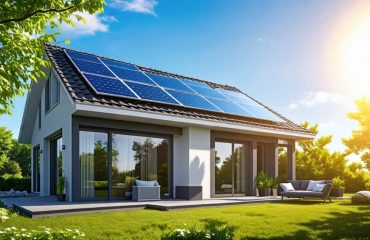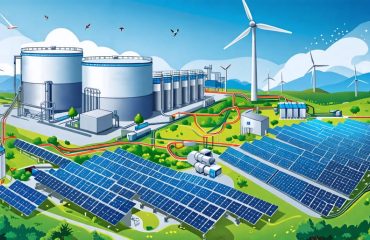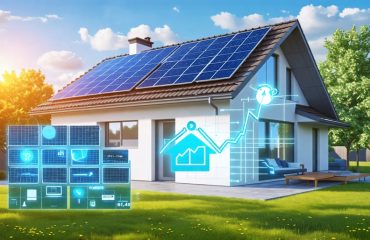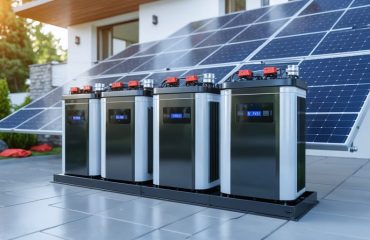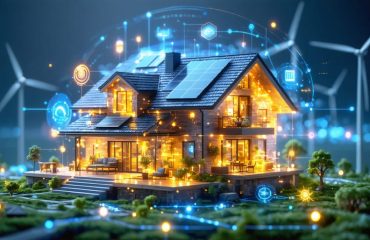Energy storage represents the missing link in our transition to a more sustainable and reliable energy future. As homeowners increasingly embrace solar panels and renewable energy, the ability to store power has become just as crucial as generating it. Think of energy storage as your home’s personal energy bank – saving electricity when it’s abundant and dispensing it precisely when you need it most.
The importance of energy storage extends far beyond just keeping the lights on during a power outage. It’s revolutionizing how we use and think about energy in our homes. From reducing monthly utility bills through strategic power management to providing critical backup during emergencies, storage systems are transforming average homes into smart, resilient energy hubs. For environmentally conscious homeowners, energy storage also offers a practical way to maximize renewable energy usage and reduce reliance on fossil fuel-powered grid electricity.
Whether you’re considering solar panels or simply want more control over your home’s energy consumption, understanding energy storage is the key to making informed decisions about your energy future.
The Power Grid Challenge
Peak vs. Off-Peak: The Energy Balance
Think of your home’s energy use like a daily dance – high during morning and evening rush hours when everyone’s getting ready or winding down, but much lower during the middle of the day and late at night. This creates a challenge for power companies, who must maintain enough capacity to meet those peak demands, even though it’s only needed for a few hours each day.
During peak hours (typically 4-9 PM), electricity costs more and often comes from less environmentally friendly sources as utilities scramble to meet high demand. Meanwhile, renewable energy sources like solar panels generate most of their power during off-peak hours when demand is low. This mismatch between when energy is produced and when it’s needed highlights why storage is crucial.
Energy storage systems act as a bridge, capturing excess power during low-demand periods and releasing it when demand – and prices – peak. This balancing act helps homeowners save money while supporting a more stable and efficient power grid.
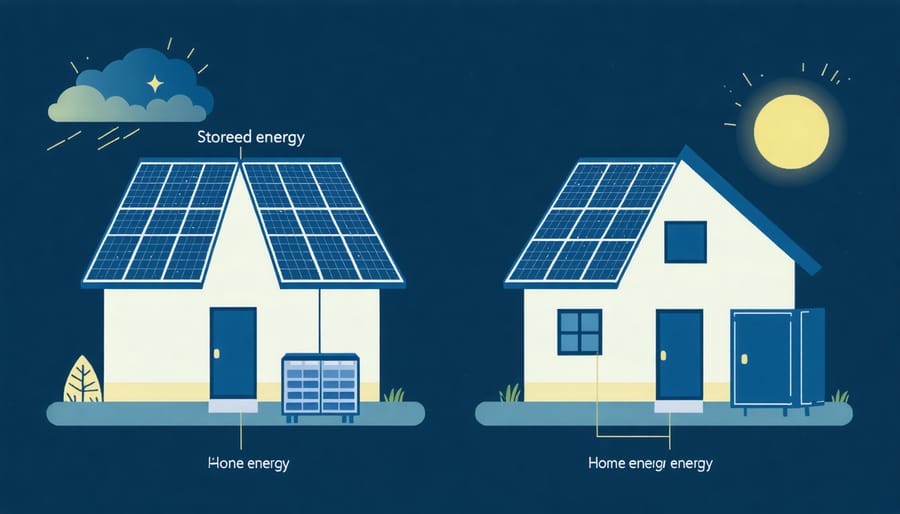
Solar’s Intermittency Solution
Solar panels generate electricity when the sun shines, but what happens when it’s cloudy or at night? This is where energy storage becomes crucial. Modern battery systems can keep your home powered 24/7, effectively solving solar’s intermittency challenge.
During peak sunlight hours, your solar panels often produce more electricity than your home needs. Instead of sending this excess energy back to the grid, storage systems capture and save it for later use. This means you can tap into your stored solar power during evening hours when your family’s energy needs are typically highest, or during cloudy days when solar production dips.
Think of energy storage like a savings account for electricity – you’re depositing excess solar energy during sunny periods and withdrawing it when needed. This continuous cycle ensures you maximize your solar investment while maintaining reliable power for your home, regardless of weather conditions or time of day.
Financial Benefits of Energy Storage
Lower Utility Bills
One of the most compelling benefits of energy storage is its ability to reduce your energy bills through smart power management. During peak hours, when electricity rates are highest, utility companies charge premium prices for power consumption. Energy storage systems allow you to avoid these high rates by storing cheaper off-peak electricity for use during expensive peak periods.
Think of it as buying groceries in bulk when prices are low, then using those supplies when prices go up. Your storage system automatically charges when rates are lowest (typically at night) and discharges during peak rate periods, effectively letting you bypass the most expensive time-of-use charges.
For solar panel owners, storage solutions provide even greater savings by capturing excess daytime solar production for evening use, rather than selling it back to the grid at lower rates. This optimization means you’ll rely less on expensive grid power and more on your own stored energy, leading to significant monthly savings on your utility bills.
Energy Independence
Energy storage systems are revolutionizing how homeowners interact with the power grid, offering a path to achieve energy independence and significant cost savings. By storing excess energy generated during peak production hours, homeowners can substantially reduce their reliance on grid power and avoid high utility rates during peak demand periods.
This independence translates into tangible financial benefits. During peak rate hours, when grid electricity costs are highest, stored energy can power your home instead of drawing from the grid. Many homeowners report saving 30-60% on their monthly electricity bills after installing storage systems alongside their solar panels.
Beyond daily savings, energy storage provides protection against rising utility rates. As electricity costs continue to climb year over year, having your own energy reserve becomes increasingly valuable. Storage systems also offer the flexibility to participate in utility demand response programs, where power companies may offer incentives for reducing grid consumption during high-demand periods. This combination of independence and financial advantages makes energy storage a smart investment for forward-thinking homeowners.
Practical Home Benefits
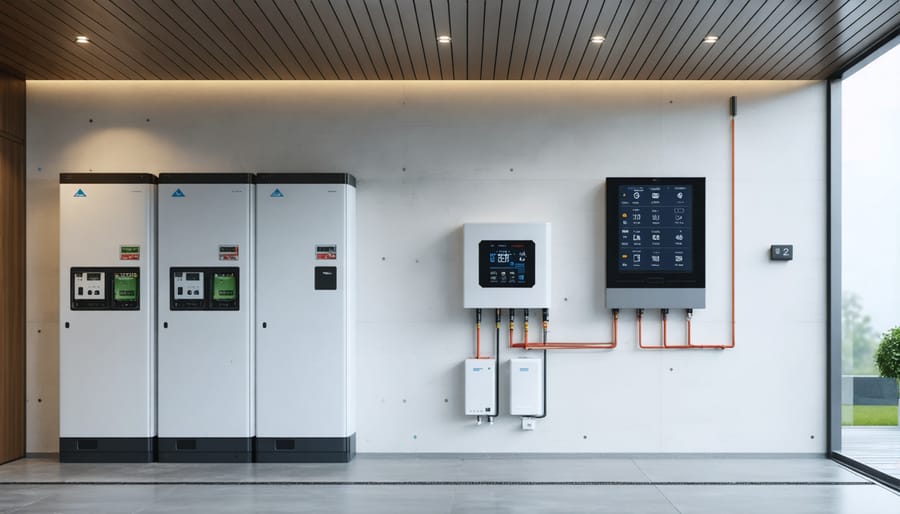
Backup Power Security
Energy storage systems serve as your home’s reliable safety net during power outages, ensuring your essential appliances and devices stay running when the grid goes down. Unlike traditional backup generators, modern energy storage solutions kick in instantly and silently, providing seamless power transition that protects your electronics and maintains your comfort.
During blackouts, stored energy becomes your household’s lifeline, powering critical systems like refrigeration, medical equipment, heating and cooling, and security systems. This becomes especially valuable during extreme weather events or emergencies when grid power might be unavailable for extended periods.
For homes with solar panels, energy storage systems are particularly valuable, allowing you to use your solar-generated power even when the grid is down. This self-reliance means you’re not left in the dark during outages, and your daily routines can continue largely uninterrupted.
The peace of mind that comes with backup power security extends beyond just keeping the lights on. It means your food stays fresh, your security systems remain active, and you maintain access to important communications devices. For families with young children, elderly members, or those working from home, this continuous power supply is invaluable.
Modern storage systems also offer smart features that automatically prioritize your most critical loads during outages, ensuring your stored energy is used efficiently when you need it most.
Smart Home Integration
Energy storage systems become even more powerful when integrated with smart home technology. Modern home automation systems can seamlessly connect with your energy storage setup, allowing you to optimize energy usage based on real-time data and your daily routines. Smart thermostats, appliances, and lighting systems can automatically adjust their operation to maximize stored energy use during peak rate periods.
Imagine your home automatically drawing from stored energy when electricity rates are highest and charging when rates are lowest. Smart systems can even learn your household’s energy patterns and adjust accordingly. For example, if your system knows you typically run your dishwasher at night, it can ensure sufficient stored energy is available during those hours.
Many energy storage solutions now come with user-friendly apps that give you complete control over your home’s energy management. These apps provide real-time monitoring of energy production, storage levels, and consumption patterns. You can track savings, adjust settings remotely, and receive alerts about potential issues or optimization opportunities.
The integration of energy storage with smart home systems also supports demand response programs. During peak demand periods, your system can automatically switch to stored energy, helping to reduce grid strain while earning you additional savings through utility incentives. This smart coordination ensures you’re always using energy in the most cost-effective and efficient way possible.
Environmental Impact
Carbon Footprint Reduction
Energy storage plays a crucial role in reducing our carbon footprint by making renewable energy sources more effective and reliable. When the sun isn’t shining or the wind isn’t blowing, stored energy steps in to power our homes and businesses with clean electricity instead of falling back on fossil fuels. This means we can use more solar and wind power throughout the day and night, significantly lowering our greenhouse gas emissions.
By storing excess renewable energy during peak production times, we prevent waste and maximize the use of clean power. For example, solar panels often generate more electricity than needed during sunny afternoons. Instead of letting this clean energy go unused, storage systems capture it for use during evening hours when solar panels aren’t producing. This creates a continuous cycle of clean energy use, reducing reliance on carbon-intensive power plants and helping homeowners maintain a smaller carbon footprint while saving money on utility bills.
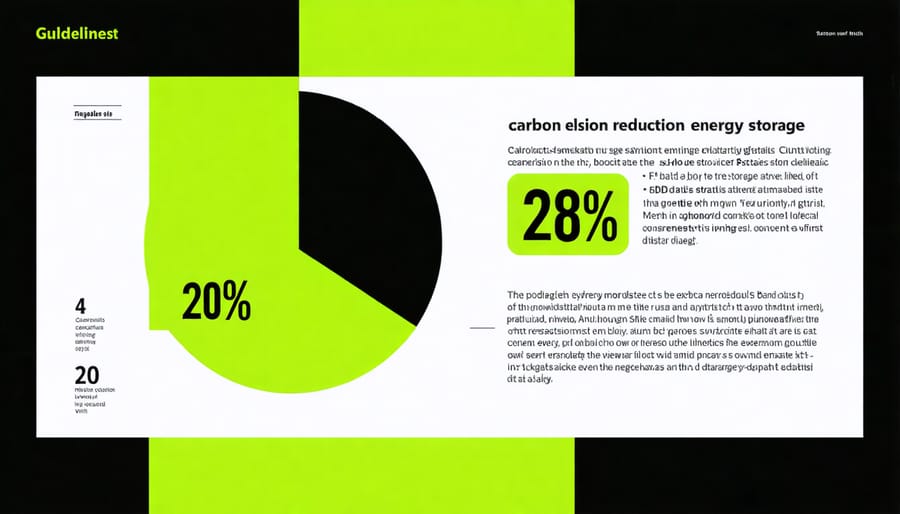
Grid Sustainability
Energy storage systems play a crucial role in creating a more sustainable and environmentally friendly power grid. By storing excess renewable energy from solar and wind sources, these systems help reduce our reliance on fossil fuel power plants, which significantly decreases carbon emissions and air pollution in our communities. When neighborhoods adopt energy storage solutions, they create a more resilient and cleaner local grid that benefits everyone.
Storage systems also help prevent energy waste by capturing surplus power that would otherwise be lost. This improved efficiency means fewer power plants need to be built and operated, reducing the environmental impact on local ecosystems and preserving natural resources. Additionally, energy storage helps smooth out peak demand periods, reducing the strain on aging power infrastructure and minimizing the need for environmentally disruptive grid expansions.
The collective impact of widespread energy storage adoption creates cleaner air, reduces water pollution from power plants, and helps communities progress toward their sustainability goals while maintaining reliable power access.
Energy storage stands as a cornerstone of our sustainable energy future, offering homeowners unprecedented control over their power consumption and costs. By implementing energy storage solutions, you can significantly reduce your carbon footprint while protecting your home from power outages and unpredictable utility rates. The benefits are clear: lower electricity bills, increased energy independence, and a more reliable power supply for your home.
As we’ve explored, energy storage systems work seamlessly with solar panels and other renewable energy sources, maximizing their effectiveness and ensuring you have power when you need it most. They offer practical solutions for both environmental concerns and economic challenges, making them an increasingly attractive option for forward-thinking homeowners.
Now is the perfect time to take action. Consider consulting with local energy professionals to explore storage solutions that fit your home’s needs. With available tax incentives and declining technology costs, investing in energy storage isn’t just environmentally responsible – it’s financially smart. By embracing energy storage today, you’re not only securing your home’s energy future but also contributing to a more sustainable world for generations to come.

